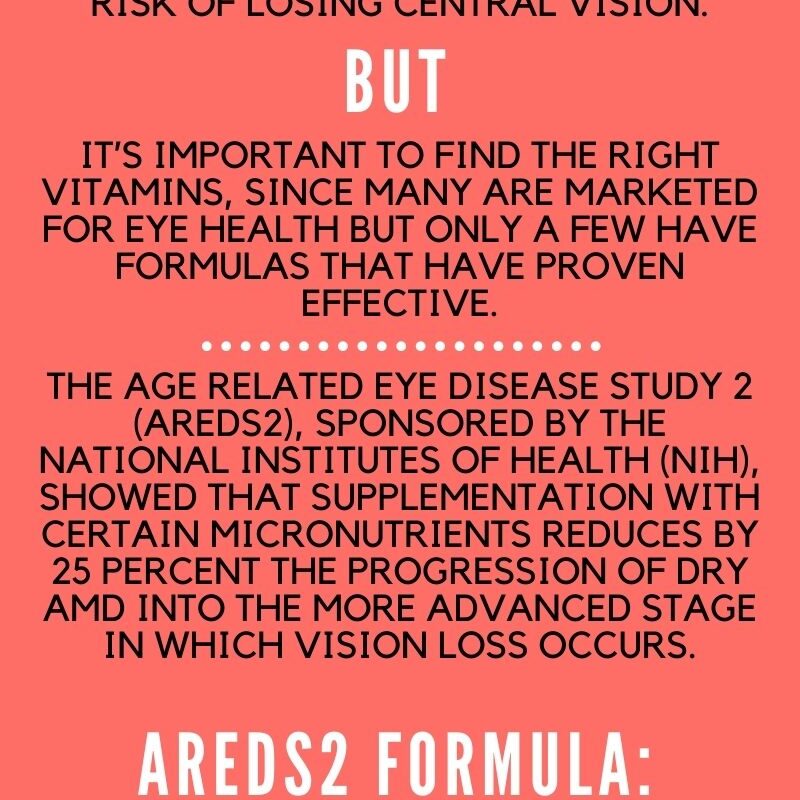Eye Vitamins can help Macular Degeneration! Studies show great improvement of those suffering from age-related macular degeneration after taking these 6 eye vitamins.
They say, “time takes its toll on the body.” And while we don’t exactly know who they are, our bodies definitely feel the effects of age in many ways.
One of those ways is through our vision.
If you’ve ever looked up at a clock on the wall and saw the clock’s numbers but not the hands, this may be your body’s way of showing Age-Related Macular Degeneration (AMD). Macular Degeneration occurs when a part of your eye’s retina — the macula — is damaged.
AMD is the leading cause of vision loss in people 50 years or older, affecting the central vision but leaving peripheral vision normal. There are multiple types of age-related macular degeneration, however, this article will focus on the treatment of the most common form of AMD.
Dry vs. Wet Age-Related Macular Degeneration and Eye Vitamins
80% of people with AMD have what is known as dry AMD. Sections of the macula thin with age, allowing tiny clumps of a protein called Drusen to grow.
These yellow deposits under the retina do not directly cause AMD but increase the risk for development. Small drusen may not cause vision problems for a while (if at all). The larger the deposits, however, the greater risk for developing a severe form of AMD.
Wet AMD, on the other hand, occurs when new, abnormal blood vessels grow under the retina. According to the American Academy of Opthalmology, “these vessels may leak blood or other fluids, causing scarring of the macula.” This form is less common but much more serious.
Am I at Risk For Developing Macular Degeneration?
The chances of developing age-related macular degeneration increase for those in the following categories:
- Consuming a Diet High in Saturated Fats
- Overweight
- Frequent Smoker
- 50+ Years of Age
- History of Hypertension
- Family History of AMD
- History of Heart Disease
- Chronically High Cholesterol Levels
If you believe you may have AMD — check, don’t guess. Schedule an appointment with your ophthalmologist to be sure. There are several ways your ophthalmologist will determine your condition. Each different test will search for either wet or dry AMD symptoms.
Eye Vitamins and Macular Degeneration
While, there is no cure for dry age-related macular degeneration, there are steps to mitigate the severity of the disease. A specific mix of vitamins and minerals, for example, may help to slow the effects of AMD.
According to the Age-Related Eye Disease Study 2, taking vitamins and minerals daily for AMD could help some people who have a lot of drusen build-up. As well, these eye vitamins may lower the risk of developing wet AMD in the future.
Vitamins and Minerals
The BIG Two
Lutein – Pronounced loo-teen, this carotenoid — also termed antioxidant – is located exclusively in the eye. Lutein filters harmful high-energy blue wavelengths of light and help protect and maintain healthy cells in the eyes. Unfortunately, the human body does not naturally make lutein so nutritional supplements are needed.
Zeaxanthin – Pronounced zee-uh-zan-thin, this carotenoid is also found in the eye. The retina, specifically, stores high quantities of this blue-light blocking agent, In working with Lutein, Zeaxanthin maintains and protects healthy cells in the eyes (especially around the retina and macula).
Other Important Players
Vitamin C – also known as ascorbic acid, this antioxidant helps promote healthy capillaries, gums, teeth, cartilage, and the absorption of iron. Almost all cells in the eye depend on Vitamin C to support the health of blood vessels in the eye. However, our bodies cannot create all of the vitamin C we need.
Vitamin E – Another powerful antioxidant not readily made in the body, Vitamin E has shown to protect the cells of the eyes from damage. Damage can be caused by unstable molecules called free radicals, which break down healthy eye tissue. When taken through supplementation or food, Vitamin E counteracts the effects of free radicals.
Zinc – In the form of Zinc Oxide, this essential trace mineral is also called the “helper molecule.” Zinc plays a vital in producing melanin, a protective pigment in the eyes. Impaired vision, such as poor night vision and cloudy cataracts, has been linked to zinc deficiency. Zinc is considered essential because the body cannot produce Zinc itself so supplementation may be necessary.
Copper – In the form of Cupric Oxide, this additional trace mineral is impeded by Zinc. In order to avoid a copper deficiency, pairing Zinc and copper together in supplementation prevents Zinc from interfering with proper copper absorption.
While these nutritional supplements (or eye vitamins as the kids say) help reduce AMD symptoms, they are not enough to prevent or delay advanced AMD. Consider the following additional steps to boost the effects of these supplements.
Additional Steps to Take for Macular Degeneration
Eat a healthy, balanced diet. These necessary eye vitamins can be found in whole foods as well. This includes dark leafy greens, colorful fruits, vegetables, and even certain types of fish! Speak with your optometrist for specific recommendations for you. After all eye vitamins can help macular degeneration.


